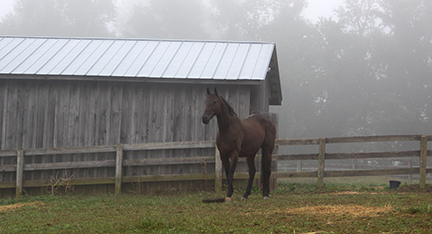 (First appeared in the April 2017 issue of The Equiery)
(First appeared in the April 2017 issue of The Equiery)
All livestock need to be contained somehow or another, for example using a cattle guard to keep cows in a certain field, but when it comes to horses there are a number of changes taking place in the law surrounding it. As of press time, both the House and Senate versions of a bill to repeal a St. Mary’s County fencing law (HB109/SB102) had passed their respective houses and crossed over, essentially making the repeal of Public Local Law Article 19, Chapter 43 “Fences” a done deal.
Enacted in 1916, the law required neighboring farmers in St. Mary’s County to install joint farm fences built to certain specifications (post-and-rail at four feet, bottom plank eight inches from ground, planks/rail no more than eight inches apart, etc.); the law goes on to detail how the fence is to be funded and maintained. Legislators in the county believe the law to now be obsolete and that fencing issues are adequately covered by common law right of contribution by tenants in common.
So what else does Maryland law say about farm fences?
For that, we turn to Paul Goeringer, an Extension Legal Specialist for the University of Maryland College of Agriculture and Natural Resources, who wrote about the topic for the Agricultural Law Education Initiative. His article limits its scope to Maryland law, which includes applications to only three specific counties (Howard, Kent and St. Mary’s). However, your county or other jurisdiction may have fencing ordinances or permitting requirements that do not appear in State Law.
Maryland Fence Laws
Maryland has adopted the traditional English common law rule of “fence-in.” The fence-in rule requires landowners to fence in livestock (which includes horses) to prevent livestock from damaging neighbors’ properties (Richardson v. Milburn, 1857). The common law puts the burden on the livestock owner to erect a division fence, or a fence separating two landowners. Landowners (farmers and non-farmers) without livestock are under no obligation to construct a fence to keep livestock off their property. Maryland has adopted this rule through court decisions, and the Maryland legislature could modify this rule at any time.
Maryland has no statewide statute or court decision defining the exact standards for constructing a fence, although some counties do. It is inherent in the law that the fence be high enough to contain the livestock within. For horse fencing, the standard minimum height to discourage jumping is four and a half feet. However, for those pasturing ponies or giant breeds, the height may be different.
Who Pays for the Fence?
Under the fence-in rule, the horse farm owner is required to build the fence, and neighboring landowners will not be required to share in this expense. The owner of the horse farm is also be required to keep the fence in good condition and to repair defects (Annapolis & Elkridge R.R. Co.).
Does this mean that neighbors can take advantage of a property line fence without contributing financially to the construction of the fence? Yes.
Good Fence Agreements Make Good Neighbors
Maryland has no law prohibiting two neighboring landowners from agreeing to share the costs of erecting a division fence even though one or neither of the landowners may own livestock. In some areas of Maryland, it has been customary that two livestock owners split costs for the maintenance and construction of a division fence. The problem with this custom is that new owners may not know the custom exists; parties may want to consider written agreements to determine how costs will be allocated. This agreement should lay out how costs will be shared, the standard by which the fence’s condition will be measured, a dispute resolution process, and other conditions for the construction and upkeep of the fence.
Howard, Kent & St. Mary’s Counties
Howard County, Kent County, and St. Mary’s County take a different approach in their county ordinances from Maryland’s fence-in view. These three counties have been granted this authority by the state to:
1. Regulate the construction and maintenance of fences;
2. Provide for a procedure to enforce the rights of parties with reference to a fence; and
3. Provide for a lien for repairs to a fence made by an owner who is not in default (Md. Local Gov’t Code Ann. § 10-318).
These county ordinances on fences clarify many of the unresolved issues in Maryland, and specify the minimum height and strength of a fence, how construction and maintenance costs will be allocated, and a procedure for collecting unpaid costs.
Adjoining landowners in Howard County are required to share the costs of constructing and maintaining a fence dividing their properties, and in Howard County, the fence cannot be within five miles of the City of Baltimore.
These ordinances also provide for processes to collect unpaid repair costs after written notice to the neighboring landowners. Howard and Kent counties require the appointment of non-interested third parties to determine if the repairs are necessary and determine a cost for the repairs. In Howard County, this determination is made before the fence is repaired and the landowner seeking the other landowner to pay construction or maintenance costs will not have to spend more than the amount set by the three disinterested landowners.
The county ordinances help clarify many issues unresolved in Maryland law, such as allocation of construction and maintenance costs. The possibility still exists for a fencing agreement to be used by neighboring landowners to further specify the allocation of construction and maintenance costs and responsibilities.
Howard, Kent, and St. Mary’s counties have clarified the height and strength of fences, methods for allocating construction and maintenance costs, and ways to collect unpaid costs. These county ordinances help clarify many of the issues that exist in the fence-in view and specify when neighboring landowners may be required to contribute to construction and maintenance of a division fence. Farm owners in other counties will want to check their own ordinances to ensure that ordinances impacting fences have not been recently enacted. Livestock owners and neighboring property owners in these counties should pay attention to their county ordinances.
One final note on fencing ordinances: Kent County’s ordinance appears to create a duty to fence out (Kent County Code § 87-5). The language of the ordinance places the responsibility on property owners to have sufficient fences to enclose their property, and property owners could potentially be liable for damages caused to a neighbor’s livestock who wander onto the property. Two disinterested and respectable neighboring property owners will be appointed to award livestock damages (§ 87-5). At least in Kent County, landowners would want to make sure they have a fence sufficient to keep livestock off their property and to prevent injury to the livestock.
Read the full version of Paul Goeringer’s article
© The Equiery 2017











